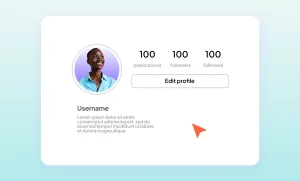Whether you're creating a podcast episode, a YouTube Short, or a branded Instagram reel, there's one thing that separates forgettable content from the kind people remember, share, and come back to: storytelling.
Storytelling is what makes people stop scrolling and start paying attention. It’s what turns a quick view into a lasting connection, and it’s the difference between content that’s forgotten and content that’s shared.
In this post, we’ll break down why storytelling works, how it shapes both audio and video content, and the simple ways you can use it to make your audience care.
Key takeaways
- Storytelling turns passive viewers into engaged audiences. It creates emotional connections that boost retention, sharing, and long-term impact across podcasts, videos, and social media content.
- Our brains are wired to remember stories, not facts. Narrative structure activates multiple brain regions and triggers emotional responses, making your message more persuasive and memorable.
- Audio storytelling relies on structure, voice, and emotion. Elements like pacing, sound design, and vulnerability shape how listeners engage and visualize what they hear.
- Video storytelling combines visuals and emotion to shape meaning. Framing, editing, and authenticity all play a role in how your story is perceived and whether it sticks with the viewer.
- Strong storytelling follows clear principles: start with emotion, create stakes, and end with meaning. Whether you’re crafting a 30-second reel or a 30-minute podcast, structure and honesty are what make people care.
What Is Storytelling?
Storytelling is how you turn an idea into something people care about. It’s more than arranging facts in order. It’s about shaping information, emotion, and pacing so your audience feels like they’re on a journey with you.
That journey doesn’t always follow a beginning, middle, and end. Sometimes it’s a quiet moment in a podcast intro that makes someone stop and listen. Other times it’s the build-up in a short ad or the quick reveal at the end of a TikTok. It can be planned and polished or completely off-the-cuff. What matters is that it feels intentional.
You see storytelling every day in tutorials, Instagram stories, brand campaigns, and vlogs. Any time you decide what to reveal first, where to pause, or how to create connection, you’re telling a story. When those decisions match the needs and interests of your audience, your content has a much better chance of sticking with them.
Why Storytelling Works
People are wired to respond to stories. Research from cognitive scientist Jerome Bruner found that we are up to 22 times more likely to remember a fact when it’s presented as part of a story. A list of facts can be forgotten quickly, but a story helps us picture scenes, imagine emotions, and feel more connected to the message.
Another study in Harvard Business Review found that storytelling can trigger the release of oxytocin, sometimes called the “trust hormone.” That chemical shift makes people more likely to feel empathy and connection. In content creation, that connection can lead to more engagement, stronger loyalty, and deeper impact.
When you frame your content as a story, you’re giving your audience something they can remember and feel. That’s true whether you’re aiming to teach, entertain, persuade, or inspire.
Audio storytelling non-negotiables
Audio storytelling challenges creators to build entire worlds using only sound. Without visuals to rely on, everything rests on how you use voice, rhythm, and atmosphere to guide the listener’s imagination. It’s a unique kind of storytelling, one that invites people to lean in, focus, and create mental images from what they hear.
Here are some key elements that make audio storytelling powerful and effective:
1. Structure matters
Just like in written or visual formats, a clear structure helps listeners stay engaged and follow the narrative. Whether you're telling a personal story with a beginning, middle, and end, or using a modular approach in an interview-style podcast, structure gives your audience a roadmap. It helps them understand where they are in the journey and what to expect next.
2. Voice is everything
Your tone, inflection, pacing, and delivery can make or break a listener’s experience. A warm, expressive voice pulls people in and creates a connection. On the other hand, a monotone or overly scripted delivery can make even the most interesting content hard to follow. Your voice doesn’t have to be “radio perfect”; it just needs to be real, intentional, and emotionally aware.
3. Sound design enhances emotion
Background music, sound effects, and ambient noise can elevate your story and set the tone. A creaking door might signal suspense. Distant waves can bring calm. Even a simple pause, when used well, can build tension or emphasize a moment. Great audio storytelling often relies on these subtle cues to guide the listener’s emotional response.
4. Character is king
At the heart of any great audio piece is the human voice and the story behind it. Whether you’re sharing your own story or amplifying someone else’s, personality and vulnerability are what make the story memorable. We connect to people, not just information. Laughter, emotion, hesitation, surprise, these raw moments give your audio depth and authenticity.
Video storytelling non-negotiables
Video storytelling adds a powerful visual layer to your narrative. Suddenly, you're not just telling the story, you’re showing it, moment by moment. This opens up new creative possibilities, but it also comes with the responsibility of making every visual decision count. The way you shoot, edit, and design your content can shape how people feel, what they remember, and whether they stay engaged.
Here are some core elements that make video storytelling work:
1. Visual narrative
Your visuals aren't just background; they're part of the story. Framing, camera angles, transitions, color grading, and lighting all communicate something, even without words. A slow zoom can build anticipation. A shaky handheld shot might feel raw and real. Warm lighting can create comfort, while cool tones might hint at distance or unease. Everything in the frame should support the message you're trying to convey.
2. Editing rhythm
Just like with audio, pacing in video storytelling is everything. Quick cuts can create energy and excitement, great for action or humor. Longer shots give the viewer time to breathe and emotionally connect with what’s happening on screen. Music, of course, is a huge part of this. The right soundtrack or well-placed beat drop can completely shift the mood or elevate the story’s emotional weight.
3. Emotional arc
Even the shortest video should take viewers on a journey. Whether you're producing a 5-second Instagram Story or a 5-minute YouTube mini-doc, you want to establish a sense of movement: What’s the challenge? Why does it matter? How is it resolved? This emotional progression gives your content shape and helps it stick in the viewer’s mind.
4. Authenticity wins
In the world of social video, high production value isn’t always the goal. In fact, audiences often connect more deeply with videos that feel unfiltered or genuine. A simple selfie-style clip where someone shares a personal story can be more impactful than a polished ad. Why? Because it feels real. And in today’s landscape, real often beats perfect.
5. Branding without being obvious
For marketers and content creators, storytelling is one of the best ways to showcase your brand without feeling pushy. Instead of leading with the product, you lead with a story, then weave your brand into it naturally. Maybe it’s the product helping someone solve a problem, or a service empowering a creative journey. When storytelling is done well, the message doesn't feel like a pitch; it feels like part of the experience.
Storytelling tips for better stories in any format
You don’t need a film degree or a background in writing to become a compelling storyteller. Whether you’re creating a podcast, a short-form video, or a branded campaign, great storytelling comes down to clarity, emotion, and structure. Here are some of the most effective tips to help you elevate your storytelling across formats:
1. Start with emotion, not information
Before diving into stats or context, ask yourself: How do I want my audience to feel? Do you want to surprise them? Make them laugh? Tug at their heartstrings? Emotion is what pulls people in; it’s the reason they keep listening or watching. A relatable moment, a surprising confession, or a big question at the start sets the stage for deeper engagement. Start with feeling, and the facts will land strongly.
2. Use the “ABT” structure: And, But, Therefore
This simple framework helps you build momentum and clarity. It works like this: “X is happening AND Y is also true, BUT there’s a problem, THEREFORE, here’s what we did.” This approach forces you to identify tension and resolution, two key ingredients of a good story. It’s flexible enough for everything from a social video to a business case study.
3. Create tension or stakes
Even the most casual story benefits from a sense of what’s at stake. What could go wrong? What’s driving the action? Why should the audience care? Stakes don’t have to be life-or-death; they can be as simple as wanting to impress someone or avoid embarrassment. But adding a layer of suspense, risk, or urgency makes your story way more compelling.
4. Think in moments
Instead of getting overwhelmed by the full narrative, break your story into key moments. Maybe it’s the first time something went wrong, a moment of realization, or a decision that changed everything. These small, vivid scenes give your story rhythm and structure. They’re also easier to pace and more memorable for your audience.
5. Show vulnerability
Stories that stick often reveal something real, an insecurity, a failure, a personal lesson. Vulnerability doesn’t mean oversharing; it just means being honest. When creators open up, audiences lean in. People connect to people, not perfection. So don’t be afraid to share the messy middle of your journey, not just the polished outcome.
6. Cut the fluff
One of the quickest ways to improve your storytelling? Edit ruthlessly. Every word, shot, or sound should serve a purpose. If it doesn’t move the story forward or add clarity or emotion, consider cutting it. Great storytelling isn’t about saying more, it’s about saying what matters most, in the clearest way possible.
7. End with meaning
Don’t let your story just drift off. Bring it home with a takeaway, reflection, or memorable final line. This could be a lesson learned, a question for the audience, or even a powerful quote that ties everything together. A strong ending lingers, and that’s what you want.
Tell your story with Podcastle
Storytelling is the heartbeat of memorable content. It’s what turns a quick scroll into a pause, a pause into engagement, and engagement into loyalty. Whether you’re sharing a personal moment in a podcast, building suspense in a short video, or shaping a brand campaign, the tools you use can make all the difference in how that story lands.
Here are 5 ways Podcastle can help you bring your stories to life:
- 1000+ realistic AI voices for narration — semantically searchable by tone, mood, and emotion so your voiceover matches your story’s atmosphere perfectly.
- AI-powered audio and video enhancement — clean up sound, remove background noise, correct eye contact, and smooth over pacing so the focus stays on your story.
- Professional editing tools — trim, arrange, and layer your clips with transitions, subtitles, and sound design that keep your audience engaged from start to finish.
- Built-in stock library — access royalty-free music, sound effects, and high-quality footage to add depth and emotion without expensive licensing.
- Easy voiceover recording — capture studio-quality audio directly in your browser, even without a mic, so you can focus on telling the story instead of troubleshooting equipment.
With Podcastle, you have everything you need to turn ideas into immersive stories your audience will remember.








